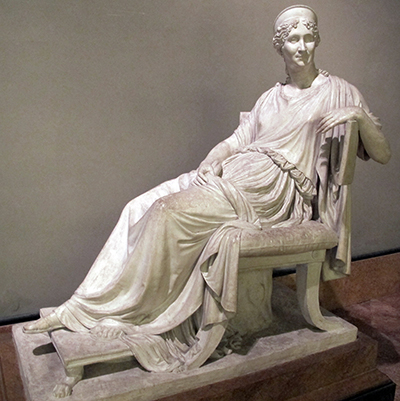This portrait of Letizia Ramolino Bonaparte was completed entirely in marble between the years of 1804-1807. It can now be found in the Devonshire Collection, Chatsworth House in the United Kingdom and remains one of the few original sculptures from Antonio Canova to be located within this country.
The sculpture features a young woman sat comfortably, but also postured in a strong and confident pose that underlines the standing of the overall family from which she derives. The Bonapartes were well known to Antonio Canova and they would commission him on a number of occasions for different sculptures, whilst also making use of other notable artists of that era in order to promote their own image as well as building up a formidable collection of art to decorate their own properties. The piece in front of us here is around a metre and a half in height, and would have required some considerable preparation by Canova prior to even getting to the point where he was working on the final piece directly. For example, he would invariably begin with drawings that increased in detail each time as he approached the final design. He would then work in clay and terracotta on small designs that would provide the basis for his later statues. He would also sometimes use these small models as a means to gaining agreement from patrons about how the final piece would look, rather than spending time on the final artwork and hoping it would be to their satisfaction.
Letizia was, of course, the mother of Napoleon I of France. She would eventually see the sculpture when it was unveiled in France and later presented it to her son soon after. Many copies were made, some of which Canova worked on himself, and others which appeared even after he had passed away from members of his studio or other followers. The Bonaparte family was heavily involved in the arts, and also helped to bring back the role of Carrara which had been a key region for sculpture in the past but had fallen out of favour more recently. The nations of France and Italy were very closely linked in a number of ways during this period of European history and Letizia herself would spend her final years living in Italy before her death in 1836 at the age of 85. She was also featured by a number of other famous artists of the era too, with Robert Lefèvre producing a memorable portrait painting in 1813 and a large number of sketched portraits existing within a variety of literature from the same period. She would go onto have 13 children during her lifetime, though five would not make it past their infancy, as was common during the 18th and 19th century.
The family would appear again in other Canova sculptures, including the likes of Bust (Colossal Head) of Napoleon Bonaparte and Napoleon as Mars the Peacemaker. Canova can be considered one of the finest sculptors in Italian art history, famed for his flair and aided by some strong connections with upper society. He ran a large studio which enabled him to attract and cater for a good number of patrons, and he also found the time to impress in other mediums as well, such as painting and drawing. He was almost akin to the great Renaissance masters in that regard, where a single medium or discipline would never be enough by itself to satisfy their creative curiosity and ambition. The portrait in front of us here allows a British audience to see an original artwork from his relatively small oeuvre up close and it remains one of the most prominent pieces within the Devonshire Collection at Chatsworth House.




